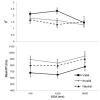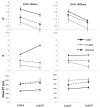Orienting attention to locations in mental representations
- PMID: 21972046
- PMCID: PMC4152722
- DOI: 10.3758/s13414-011-0218-3
Orienting attention to locations in mental representations
Abstract
Many cognitive processes depend on our ability to hold information in mind, often well beyond the offset of the original sensory input. The capacity of this visual short-term memory (VSTM) is limited to around three to four items. Recent research has demonstrated that the content of VSTM can be modulated by top-down attentional biases. This has been demonstrated using retrodictive spatial cues, termed "retro-cues," which orient subjects' attention to spatial locations within VSTM. In the present article, we tested whether the use of these cues is modulated by memory load and cue delay. There are a number of important conclusions: (1) Top-down biases can operate on very brief iconic traces as well as on older VSTM representations (Exp. 1). (2) When operating within capacity, subjects use the cue to prioritise where they initiate their memory search, rather than to discard uncued items (Exps. 2 and 3). (3) When capacity is exceeded, there is little benefit to top-down biasing relative to a neutral condition; however, unattended items are lost, with there being a substantial cost of invalid spatial cueing (Exp. 3). (4) These costs and benefits of orienting spatial attention differ across iconic memory and VSTM representations when VSTM capacity is exceeded (Exp. 4).
Figures






References
-
- Averback E, Coriell AS. Short-term memory in vision. Bell Systems Technical Journal. 1961;40:309–328.
-
- Cowan N. The magical number 4 in short-term memory: a reconsideration of mental storage capacity. Behav Brain Sci. 2001;24(1):87–114. discussion 114-85. - PubMed
Publication types
MeSH terms
Grants and funding
LinkOut - more resources
Full Text Sources

